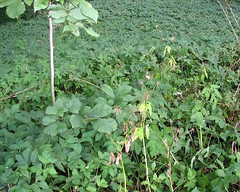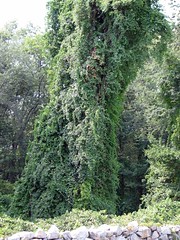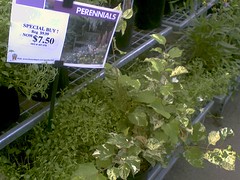Insect curious? There's a new edition of Circus of the Spineless out over at Sunbeams from Cucumbers that's just for you. It's chock full of invertebrate goodness (insects and more!), and infused with a spicy blast of ISW.
Thursday, August 31, 2006
Wednesday, August 30, 2006
Oh Seychelles, You See
The Seychelles Nation is reporting that the Republic of Seychelles recently designated an official ballast water exchange zone for ships stopping at their island nation. The decision is a direct result of the discovery of three species of introduced bryozoans in the island waters. The site of exchange, located about 80 miles from Port Victoria, is now marked on all charts distributed to visiting ships.
At the end of the article, there is a note from an IUCN scientist that ballast discharge is less of an issue for Seychelles because it is mainly a country of imports, meaning that ships are weighed down by the goods they arrive with and need to take on ballast water when they depart. I look forward to the results of the IUCN study that will reveal whether this is truly the case (though it apparently started in 2004 so I am not sure what its status is).
Tuesday, August 29, 2006
Canary Ponzi Scheme
The New York Times filed this report about invasive species on the Canary Islands. Scientists are concerned that species like the introduced Barbary ground squirrel (Atlantoxerus getulus) and Corsica mouflon sheep (Ovis ammon musimon) are destroying species that have not even been discovered by humans yet. Oddly, there is only a passing mention of the introduced plants that now call the Canary Islands home, like America's prickly pear cactus (Opuntia spp.) and the South African ice plant (Mesembryanthemum sp.).
Local government officials think the solution to the invasive species problem is to wrest control of the islands away from mainland Spain and transfer it to...local government. Will Spain step up to the plate on this issue or will they risk letting this ecological goldmine be wiped out?
Xris over at the Flatbush Gardener sent an email about the story as I was crafting this post - kismet!
Monday, August 28, 2006
Swiss Amiss
A recent swissinfo article discusses the spread of ragweed (Ambrosia artemisiifolia) throughout that country. This allergy-aggravating plant, well-known in its native North America, is just reaching peak pollen-producing levels in Switzerland this month. The problem is so new there that allergists are still deciding what recommendations to make to current and potential patients. Estimates indicate that ragweed pollen will negatively impact about 14% of the Swiss population. Switzerland had been dealing with burgeoning ragweed populations for many years - the ISW first reported about it back in 2004.
Sunday, August 27, 2006
Weekend Blog Blogging
This weekend in invasive species blogging:
- The Botany Photo of the Day for Saturday is Orbea variegata, an invasive species in Australia. So pretty! :-)
- Did introduced rats and chickens cause the downfall of Rapa Nui? Daniel Drezner, The Volokh Conspiracy and others are blogging about Terry Hunt's essay in American Scientist that questions Jared Diamond's supposition of tree-felling as one of the major causes.
- piranha's nest has got some cringe-inducing shots of European wasp nests...in Canada.
- johnatnocorners blogs about Himalayan balsam - nice photos John!
Field of Goutweed

Field of Goutweed
Originally uploaded by urtica.
Probably originally planted as a ground cover, the goutweed (Aegopodium podagraria) has certainly taken over this patch of understory at the edge of Forbes Woods in Milton, MA.
Friday, August 25, 2006
Fun with Google
Let the battle begin! ...
- Number of hits for "invasive species": 12,600,000 (a 400% increase since October 2005!)
- Number of hits for "exotic species": 2,930,000
- Number of hits for "alien species": 2,090,000
- Number of hits for "introduced species": 1,370,000
- Number of hits for "non-native species": 1,070,000
- Number of hits for "non-indigenous species": 409,000
- Number of hits for "nuisance species": 376,000
Thursday, August 24, 2006
Bow Regards
There is an interesting article from the Detroit Free Press about a fisherman that volunteers his "services" to anyone in Michigan with a lake filled with fishy invaders like carp (but also natives like gar and dogfish too). What makes this story worth posting is the way this guy makes his catches: night bow-fishing. That's right, not just fishing, but fishing with a bow on a 21-foot pontoon boat lit up like a cruise ship (see photo accompanying article).
A nuisance, or a valiant effort to fight invasive species? The noise and light certainly hasn't made this guy a lot of friends among those who own lakeside property, and a fisheries biologist notes that there's no way this technique could be removing enough carp to make a dent in that problem. I think the guy's just in it for the sport. But it sounds better than the anti-bow fishing Carp Anglers Group, who catch the darn things and then release them back into the water.
Wednesday, August 23, 2006
Bermuda Short
The Royal Gazette is reporting that the island of Bermuda is considering instituting a banned species list to prevent further introductions of invasive plants and animals. The details can be found in the draft of the Sustainable Development Strategy and Implementation Plan, which you can read in its entirety here (.pdf)...or just skip to Option 3.5.A.3 :-).
Tuesday, August 22, 2006
An Incomplete Bore
Back in 2003 the ISW posted about the discovery in Maryland of an ash tree infested with the emerald ash borer (Agrilus planipennis). Now, almost three years later, Maryland's Department of Agriculture has issued a press release stating that the EAB has been found once again in that state. The beetle larvae were discovered in "trap" trees specifically monitored for the presence of the insects. It's good to see Maryland being extra cautious even after so many months with no sign of the invasive insects. The state is now expanding their tree surveys to a much larger area and has instituted a quarantine on all ash trees or any hardwood firewood in Prince George's County, where the beetles were discovered.
Information posted to the Yahoo! group ma-eppc was also used in this post.
Monday, August 21, 2006
Oy to the World
The AP is reporting that a team of workers removed more than 250 individuals of an introduced, unindentified species of oyster from San Francisco Bay last week. The oysters are massive compared to the native versions, with shells as much as nine inches wide. While the first known occurrence of this species in the bay was likely an empty shell found back in 2004, no sign of a live specimen was ever seen until this find. For more information, check out this expanded story (.pdf) and this audio report and excellent photo over at NPR's website.
Sunday, August 20, 2006
Weekend Blog Blogging
This past week in invasive species blogging:
- Be sure to check out the pithy new invasive species course blog for bcb 722. Who knows, if you read it all and pass the test, you could receive 10 credits :-).
- J.D. Adams over at Onward Oregon blogs about the invasive species in that state. Ella Tyler does the same for Texas over at the Citizens' Environmental Coalition blog.
Saturday, August 19, 2006
Weekend Photoblogging

The Wizard of Kudzu
Originally uploaded by a47nn.
Some major pareidolia going on here...Looks like the kudzu has not only taken over a light pole, it is preparing to cast a spell over all of North Carolina! Oh wait, it already has? :-) The light on that pole has ceased functioning, by the way.
Thanks to a47nn on Flickr for allowing me to post this on the ISW.
Friday, August 18, 2006
The Grass Is Always Meaner...
Back in 2004, the ISW posted twice about the herbicide-resistant creeping bentgrass cultivar that was going to be the answer to everyone's perfect green lawn. Creeping bentgrass (Agrostis stolonifera) is already a weed in many places, so the news that this cultivar has been discovered growing in the wild is no big surprise. What *is* a surprise is that this discovery is not the end of the efforts to get the cultivar approved for use in the U.S. A spokesman for the Scotts Miracle-Gro company, one half of the collaboration that lead to the development of a turf grass resistant to Roundup (the other half is Monsanto) notes that "Eradicating it has not been a difficult issue" - guess that makes it okay to grow it. Stay tuned to the ISW in 2008, when there is sure to be a post about wild bentgrass picking up herbicide-resistance from its genetically engineered brethren.
Thanks to several ISW readers who sent in links to this story.
Update: Fox News notes that this grass was engineered specifically for use as golf course turf, making it even more evil! ;-)
Thursday, August 17, 2006
Update to "Knotweed for Sale" Saga
There is an update to the story of "The banned Japanese knotweed for sale in a Massachusetts Home Depot" here.
Just a reminder that effective invasive species outreach needs to include full scientific and common name synonymy for any organism being used, grown, or kept by the public. "Don't plant Polygonum cuspidatum" is not going to stop the average person from buying the same species if it is labeled "Fallopia japonica (Apparently it's not going to stop the average nursery worker from selling it either). Read on...
Wednesday, August 16, 2006
Goby Trick
Round gobies (Neogobius melanostomus) have made it in to Lake Simcoe in Ontario, Canada, according to this story at myKawartha.com. The news is disappointing to many, especially after workers spent significant money and time last year treating the adjacent Pefferlaw Brook with rotenone (a piscicide) in order to prevent the gobies from making it to the Lake.
Tuesday, August 15, 2006
Err Pollution
As reported by ABC Australia, scientists in that country have found that water pollution may benefit marine invasive species. Specifically, certain invaders, including red bryozoans (lace corals), were shown to have evolved an increased tolerance for copper in the water. This is bad news when you consider that the main component of anti-fouling ship paint is copper, meaning that the use of a product meant to stop the spread of invasive species on ships may actually be selecting for pollution-resistance among those invaders. As if they need another avantage over native species!
Monday, August 14, 2006
Pythonian Measures
Seems like pythons are everywhere in the news lately. Is it all just movie hype? It cannot just be a coincidence that within four days we get this ABC News video (a nice one, if you can stand the annoying ads), this Tampa Tribune article, and this Indy Star article about a 19-foot python on the loose in Indiana.
Turns out National Geographic is likely responsible for some of the media blitz. They've got a new special coming up this weekend, "Python vs. Gator", that tells the tale of the ongoing Everglades battle between the native American alligator (Alligator mississippiensis) and the introduced Burmese python (Python molurus bivittatus). I'll be setting up the Myth box to record this one for sure!
Sunday, August 13, 2006
Weekend Photoblogging

Pseudo-tree
Originally uploaded by urtica.
Asiatic bittersweet (Celastrus orbiculatus) covering almost every bit of whatever used to be growing here by the Ashland Reservoir. At the very, very top of the "tree" in this photo were a few branches with leaves from the actual tree. Ok bittersweet, you win. :-)
Saturday, August 12, 2006
Last Chance to Win!
Last chance to enter the "Your Punny Title Here!" contest - deadline is Monday, Aug. 14th.
Friday, August 11, 2006
Boring!
The Pennsylvania Department of Agriculture is reporting that a woodboring wasp that attacks pine trees, Sirex noctilio, has been discovered in their state. The wasp is a relatively recent arrival to the U.S., first spotted in New York in 2004. Workers will be monitoring insect traps over the next few weeks to try to get a better idea of just how many wasps there are in the area. In the meantime, Pennsylvania is asking people to help prevent the spread of the wasps by avoiding the transport of firewood or logs away from the areas they originate from.
Thursday, August 10, 2006
Crabtastic
BBC News is reporting that Norway fears the invasion of the red king crab (Paralithodes camtschatica) is imminent. Maybe "continues to fear" would be the right way to describe it, since some version of this article seems to pop up in the British press every couple of years., along with the requisite reference to how great it would be if we could eat all the darn things up (mmmm....crab). I now know that if I ever go to Norway, I need to be sure to sign up for one of these crab safaris so I can pick up my own dinner off the bottom of the ocean (mmm...takeout takeaway).
Wednesday, August 09, 2006
Meow!
The University of Michigan News Service has an article about an interesting study involving native and non-native cattails. Two biologists performed experiments in Michigan marshes, where the native broad-leaf cattail (Typha latifolia) and introduced narrow-leaf cattail (Typha angustifolia) grow and hybridize (Typha x glauca). Noting that the hybrid was more common than the native broad-leaf, the researchers set up plots with both types of cattails and added leaf litter to some of the plots. Their results indicate that the leaf litter was altering the marsh environment by decreasing soil temperatures and increasing nitrogen levels. Turns out the hybrid has a competitive advantage over the native in that altered environment, so the litter is creating a feedback loop that could feasibly wipe out the native species.
Thanks to Tim over at Walking the Berkshires for sending in a link to this story.
Tuesday, August 08, 2006
Russian Blessing?
North Dakota is debating whether to stop loving Russian olive (Elaeagnus angustifolia) quite so much, according to this article in the Grand Forks Herald. It turns out that not only is the invasive tree currently legal to plant in that state, its planting is actually sanctioned and subsidized under a cost-sharing tree-planting program. Now the state's National Resources Conservation Service is seeking comments from landowners about whether the tree should be removed from that savings program, as has been done in neighboring Minnesota. The decision certainly won't be cut and dry - many people still value the tree as one of the only species that will grow in highly disturbed habitats. Meanwhile, the state department of Fish and Game will keep planting it, but promises to be "very, very careful" about it.
Monday, August 07, 2006
Maryland Crab Cakes
The Baltimore Sun is reporting that a Chinese mitten crab (Eriocheir sinensis) has been found in the Patapsco River in Maryland. A crabber discovered the non-native species this past June when checking his pots for crabs. This is the first record for the Chinese mitten crab in Maryland or anywhere in the Chesapeake region - they've been on the west coast of the U.S. for a while now.
Update:As an anonymous ISW reader points out in the comments below, a second Chinese mitten crab has been found from the same river, from a catch over one year ago. Kudos to the volunteer park ranger who heard the alert that went out and realized he had one of the crabs in his freezer.
Sunday, August 06, 2006
Weekend Blog Blogging
This week in invasive species blogging:
- AOL's Down to Earth blog reviews Alan Burdick's book, "Out of Eden," and gives it a thumbs up.
- Want to know what invasive plants plague Thomasville, Alabama? Check out this post over at April's Insider Report.
- Mr. Punky Kitten blogs about garlic mustard. Mr. Punky Kitten??? lol
- The Calypso Island Chronicles posts about the Mexican sunflower, Tithania diversifolia, an invasive species in Asia and Africa.
- The Kids in the Creek created an invasive species pamphlet to print and distribute to folks in Shasta County, California.
- Roger over at Words & Pictures posts about a survey about invasive plants in Britain. He's got some valid criticisms, and a copy of their silly poster.
Weekend Photoblogging

Knotweed for sale...illegally
Originally uploaded by urtica.
Yesterday I was walking through the garden section at the local Home Depot when I suddenly recognized something I should not have been seeing: Japanese knotweed! There were at least two pots of this variegated Japanese knotweed cultivar (often sold as "Fallopia japonica 'Variegata'"), and neither of them were labeled with any information other than "perennial" and the Connecticut nursery that they originated from.
Why is this a big deal? Well, here in Massachusetts, Japanese knotweed is one of over 100 invasive plants whose import and propagation has been banned since January 2006. The ban includes any cultivars and hybrids.
Some of you are probably wondering why I didn't just complain to the manager and try to get them removed on the spot. My reasoning is that there are bigger issues here:
- Two plants in one store is one thing. Unlabeled plants being distributed by a New England grower is another. Were these leftovers from last year? Who knows. I'm a big fan of tagging (just check out more of my Flickr photos). Tagging imparts knowledge. Let's give gardeners all the knowledge they need to make good choices about what to plant.
- There appears to be no protocol in place by which a concerned citizen can report a violation of the ban to the state. This page from the Department of Conservation and Recreation indicates a violator could get a warning or even a $1000 fine. But check out the official web documentation from the Massachusetts Department of Agricultural Resources and just try to find anything about a reporting process or the consequences if someone violates the ban.
I have contacted someone that works for the state and will update this post as I find out more about what can be done.
P.S. - Those of you who are interested in Japanese knotweed and also dabble in photography should consider joining the Life on the Japanese Knotweed photo documentation project. Last year's Life on the Purple Loosestrife was a resounding success!
Update 08/17/2006: The Massachusetts Department of Agricultural Resources sent someone out to the Home Depot to inform them of the problem and issue a "stop sale," but they could not find the plants in question (they were probably sold). They also contacted the Connecticut nursery from which the plants originated from. The nursery indicated that they had sold the variegated knotweed plants to several Home Depots under the synonym "Fallopia japonica" and did not believe it was on the prohibited list for Massachusetts, which lists Japanese knotweed as "Polygonum cuspidatum." The nursery will be getting a "stop sale" order as well...and hopefully will decide to educate themselves more about the plants they shouldn't be selling!
Friday, August 04, 2006
Flock Me Like A Hurricane
The Lippard Blog has posted an incredible video of a starling flock (Sturnus vlgaris) in flight. In the video, originally posted over at Rocketboom, a family watches and records as hundreds of the birds take flight, and then repeatedly descend on a poor little cedar tree that bends under their weight. It's actually quite a beautiful clip to watch, and I got a laugh out of the videographer's comment about the scientific name of the starling.
Tip of the virtual hat to Pharyngula for posting a link to the video (worth clicking through just to read the reader comments).
Thursday, August 03, 2006
Lionfish Spikes on Cape Fear? Oh, my! (We Have a Winner!)
I can't think of a good punny title for this story. If you can, you may win a cool "Pests in Your Lake" sticker and a Vermont State Park pass, or your choice of anything from the ISW store! Post your entry here or email it to me (link on the left), ONE PER PERSON. Deadline is Monday, August 14th. Interested readers may want to check out the last punny title contest here.
Here is the story:
The current version of NOAA News Online features an article about ongoing project to research the range and spread of the lionfish (Pterois volitans) in the Atlantic Ocean. NOAA scientists are partnering with the Essential Image Source Foundation (EISF) to raise awareness about the escape and establishment of this popular marine aquarium inhabitant through a weblog maintained by the EISF. While it may sound pretty mundane in this day and age to say a project has a blog, the Lionfish Research Mission Log actually live blogs the research missions from the boat they are using to survey the Atlantic for lionfish. Here's the entry for August 2nd. A quick P.S. to the EISF though: get yourself a nice domain name for the lionfish blog instead of burying the site deep inside your own portal.
Update: A winning entry was selected, but I am having trouble contacting the person who submitted it. Stay tuned...
Congratulations to just john for coming up with the winning entry
Wednesday, August 02, 2006
A Foul Wind in the Willows
The New Zealand Herald is reporting that Waitakere City is considering doing aerial spraying of herbicide to combat invasive willow trees. The targeted invaders are grey willow (Salix cinerea) and crack willow (Salix fragilis) trees growing in areas that are hard to reach on foot. The willows, which can regenerate easily from broken branches or even bark, cause flooding in the area by growing over and blocking drains.
Tuesday, August 01, 2006
Fox...or Chupacabra?
Somehow, even after reports of foxes attacking chickens and numerous scat samples testing positive, Tasmanians were still not ready to accept that the European red fox (Vulpes vulpes) now calls their island home. It took a fox carcass discovered on a road in the Northern Midlands to really get the Aussie media riled up. Even so, I'm not sure the general populace of Tasmania is convinced - see this article from the Mercury and then these rather wishy-washy reader comments. As to why someone would think the carcass was *planted*, I have no idea - what possible benefit to the island could that have?
Interested readers will want to check out this previous ISW post about foxes in Australia.